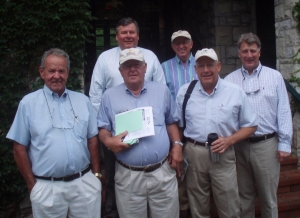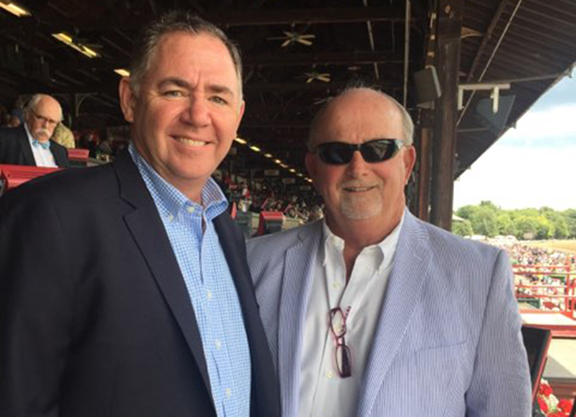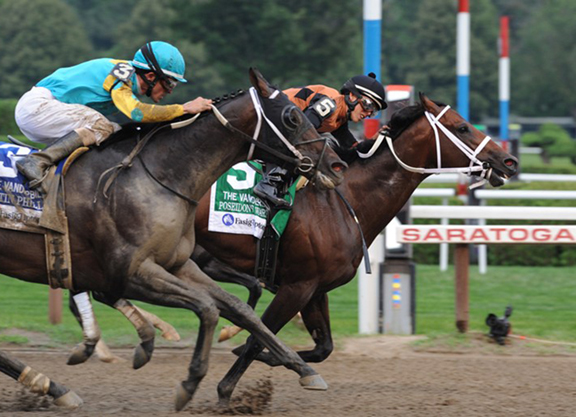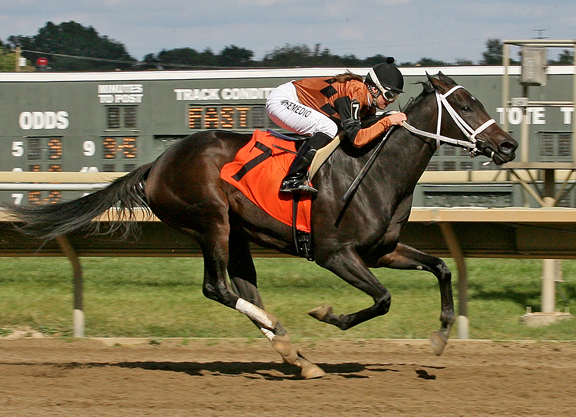After completing our marathon tour of covering options in the Bluegrass, today we take a tour of the main regional hubs. Clearly, it would be impractical to go into anything like the same depth and, besides, local breeders know their own markets best. But while we will only visit some of the principal centers, and pick out only one or two names in each, bloodstock investors anywhere can acknowledge the professionalism that unites horsemen, coast to coast, and think about the possibilities of diversification or experiment–above all in those programs that are incentivizing investment so successfully.
For one thing, many stallions discarded prematurely by Kentucky will deservedly flourish as bigger fish in smaller ponds. I'm sure that can still be the case, for instance, with Fed Biz–the son of Giant's Causeway making a fresh start at Highfield Stock Farm in Alberta. He has made a highly respectable start on the track, with only Cairo Prince in their intake exceeding his nine stakes winners to date, but just ran out of commercial oxygen where he was. Access to this true aristocrat, who beat Goldencents in a Del Mar track record, gives local breeders an exciting chance to raise the bar at $4,000.
Equally, of course, there have been many cases of sires working the reverse passage after starting out with regional mares–some, indeed, becoming massive influences–and those who have transferred Laoban to the Bluegrass from New York will be hoping that he can follow suit.
So we know for a fact that there will be stallions offering good value out there. Let's look for one or two nuggets.
FLORIDA
The big news round here is unmistakably Khozan (Distorted Humor), who maintains the highest fee in the state after winning its 2020 championship with only his second crop on the track. Nationally he stands fifth, by cumulative earnings, among his intake.
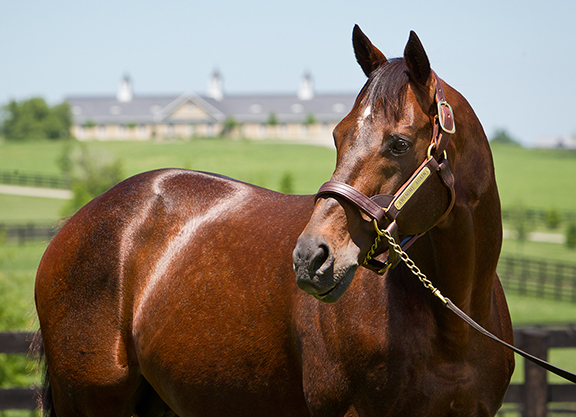
The late Awesome Again is an influence in Florida with Awesome Slew and Awesome of Course | Matt Wooley/EquiSport Photos
Royal Delta (Empire Maker)'s half-brother, a $1-million Fasig-Tipton Florida 2-year-old, would hardly be the first to become a significant influence after derailing so early in his track career. We'll see how far he can go, but it's surely only a matter of time before he makes a graded stakes breakthrough after five black-type winners last year. The great thing is that his stock should continue to thrive: being out of an elite producer by A.P. Indy, he's hardly confined to “Florida speed.”
But the word is out and he welcomed 181 mares to Journeyman Stud last year. And he can't be the only show in town. Even within his own class–i.e. about to launch a third crop of juveniles–The Big Beast (Yes It's True) is matching Khozan's ratio of winners and he, too, has two graded stakes performers to date. And, of course, he is less than half the price.
Brethren, by the same sire as Khozan and now with a first graded stakes winner in Cookie Dough (and overall 10.7% black-type horses-to-starters), and First Dude (Stephen Got Even) punched their $7,500 weight for second and third in the earnings table, albeit arguably nobody gives value more consistently than Adios Charlie (Indian Charlie) at just $4,000. His latest flagbearer Jean Elizabeth has been beaten once (by a nose) in her last 10 starts, including two at graded stakes and six at black-type level.
On the same Ocala Stud roster there's now a chance to tap into one of the great modern families through Seeking the Soul (Perfect Soul), while the first four dams (Live Oak family) of Awesome Slew (Awesome Again) are all graded stakes performers and producers. But don't forget another heir to the same, sadly departed sire: Awesome of Course (Awesome Again–Mais Oui, by Lyphard), even though he is now an acknowledged veteran quietly plying his trade to tiny books at $2,000.
Awesome of Course has real breadth of achievement, crowned by four graded stakes winners and five Grade I performers including Breeders' Cup champion Awesome Feather. In 2020 he numbered Florida Derby runner-up Shivaree among eight 90+ Beyers, so he's still keeping up an absolutely excellent output for this kind of fee.
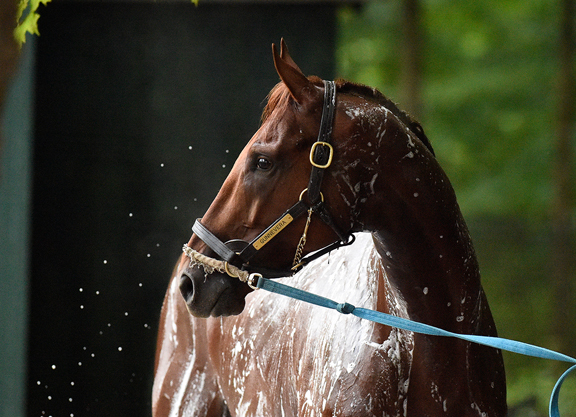
Gunnevera | Sarah Andrew
In terms of fresh blood, meanwhile, it's good to see some promising two-turn stallions around the state (and some decent turf quality, too). The closing kick of Gunnevera (Dialed In–Unbridled Rage, by Unbridled) became so familiar–he was still picking up the pieces in the G1 Dubai World Cup at five, his sixth elite podium–that we tend to forget how he was already rolling in time to win the GII Saratoga Special S. And though he arrives at Pleasant Acres for $6,000 as a famous rags-to-riches story, you couldn't ask for better seeding of his family: first four dams by Unbridled, Graustark, The Minstrel and Turn-to.
Pleasant Acres Stallions is also home to Bucchero (Kantharos–Meetmeontime, by General Meeting), who has covered 291 mares in his first two years in the breeding shed, tops among all Florida-based stallions. Bucchero is a half-brother to the dam of dual-surface Grade I winner and Hill 'n' Dale-based World of Trouble (Kantharos), and he was the leading Florida stallion by average and median at last month's OBS Winter Mixed Sale, his first yearling through the ring having sold for $45,000, nine times his stud fee.
In the market backwaters, meanwhile, there's something pretty remarkable astir in Cajun Breeze (Congrats–Cajun Dawn, by Awesome Again), who is operating on private-treaty terms at Stonehedge Farm South. His track career (four-for-33) gave him highly marginal claims to one at stud, but the fact is that he has had a stakes winner from each of his three crops to date, despite an aggregate of only 31 runners (of which 19 are winners). He just came up with his fourth black-type winner in Cajun Brother, winner of the $75,000 Sunshine Sprint S. I can't really figure it out, either, even if the fourth dam is the very productive Fred W. Hooper mare Queen Pat (Crozier), but something seems to be working and people are gradually cottoning on: Cajun Breeze inched up to 45 mares last spring.
And I'm sorry, but I can't resist stressing that the venerable Greatness (Mr. Prospector–Harbour Club, by Danzig)–with another small firm, in Solera Farm–offers something pretty unique, nowadays, as a son of one breed-shaper out of mare by another, with next two dams by Graustark and, wait for it, Bold Ruler! His books/crops have largely dried up but he has sired some very tough and talented runners in his time (Lady's Island, aged six, won her latest graded stakes just before Christmas before selling for $310,000 at FTKFEB) and, if you could get a filly out of him, how could you price that bloodline at just $2,500? So please do the whole breed a favor and get a last residue of Greatness while we can!
NEW YORK
A changing of the guard here, with stalwarts Bellamy Road (Concerto) and Frost Giant (Giant's Causeway) pensioned even as the heavily subscribed young sensation Central Banker (Speightstown) charged into the slipstream of veteran Big Brown (Boundary) in the state championship–with only a third crop of juveniles in play. With six stakes winners to date, Central Banker stands fifth nationally, among his intake, in cumulative earnings.
Leading the next cycle, the imaginatively promoted War Dancer (War Front) duly became champion freshman, highlighted with a one-two at Saratoga. No less than anywhere else, however, newcomers will doubtless be in strong demand as everyone seeks out the next Laoban.
The most obvious candidate appears to be Solomini (Curlin), as a notably accomplished juvenile for a sire sooner associated with two-turn maturity, from the family of Frosted and Midshipman; so obvious, in fact, that he corralled the biggest book in the state (123) for his debut season alongside Central Banker at McMahon of Saratoga.
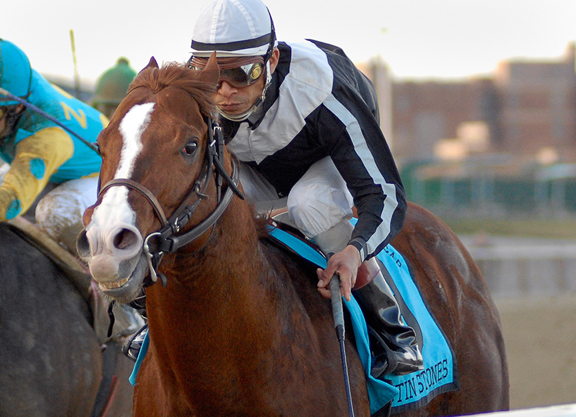
Bustin Stones | Sarah Andrew
But your heart meanwhile goes out to some who are doing pretty well from limited opportunity. Yes, there is bound to be much interest in Mr. Monomoy (Palace Malice) at Waldorf Farm, yet poor old Bustin Stones (City Zip–Shesasurething, by Prospectors Gamble) will be entitled to glare at breeders driving the van past him at just $2,500.
He doesn't have his new neighbor's glamorous pedigree–Mr. Monomoy is, of course, a Grade II-winning half-brother to Monomoy Girl (Tapizar)–but he was a very fast horse (GI Carter H., 109 Beyer) who once again came up with his mandatory stakes winners in 2020 (plus seven 90+ Beyers), while confined to a much smaller pool of talent than those he annually joins in the top echelons of the prize money table.
Above all, simply in terms of bang for buck, it feels crazy that you can now get to a stallion as accomplished as Freud (Storm Cat–Mariah's Storm, by Rahy) for just $5,000 at Sequel Stallions. I know he will probably benefit from suitably restrained management, now that he's 23, but Speightstown just got a big fee increase–and he's three weeks older!
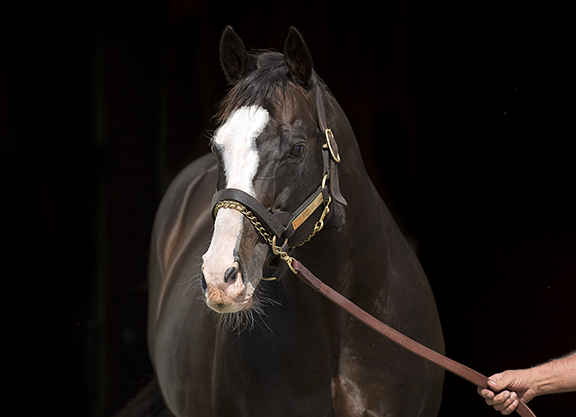
Freud | Sarah Andrew
Freud remains an Empire State legend, as a six-time champion and brother to Giant's Causeway, and proved as potent as ever in 2020 with a state-high five stakes winners, eight stakes performers and 15 Beyers of 90+ from fewer runners than Big Brown and Central Banker, the only pair to exceed his earnings. His lifetime numbers put a whole bunch of expensive Kentucky stallions in the shade, with 55 winners and 109 performers at black-type level clocked at a ratio, against named foals, of six and 12% respectively; while his 10 graded stakes scorers include four at the elite level.
We've often spoken about the self-fulfilling prejudice against ageing stallions, and I guess some people would be embarrassed to pick one as “exposed” as Freud as the best value in the state against all these sparkly new stallions. But that's just what he is, and you know it. (If, that is, you want to breed yourself a racehorse.) In fact, there can't be much better value around, coast-to-coast, than Freud at a fee so much lower than all those Kentucky rookies with little realistic prospect of getting anywhere near his record.
A son of Freud's illustrious brother who has been around for a while without ever gaining much profile, meanwhile, is Giant Surprise (Giant's Causeway–Twisted Sis, by A.P. Indy) at Rockridge. His public career lasted 70 seconds in a Saratoga maiden, flimsy-enough grounds for a place at stud, but he has never failed to sire winners at a good percentage from a marginal foothold (including in 2020, with 20 from 37 starters) while his handful of black-type winners are headed by an earner of over $800,000. His dam is by A.P. Indy out of a Grade I winner and, still only 11, he is going to pull a smart one out of his hat someday at just $2,500.
MID-ATLANTIC
There's a big, Jump Start-sized hole hereabouts, as can be seen from the seventh consecutive championship posthumously secured by the Pennsylvania legend in 2020. Warrior's Reward, the strapping son of Medaglia d'Oro brought to the same state in 2018, did reiterate his credentials among active sires and remains in corresponding demand; while those eager to maintain the A.P. Indy connection, and at a very competitive rate, will see Friesan Fire ticking along reliably at Country Life. But a more recent recruit to the same roster has made an auspicious start in the quest to fill the gap.
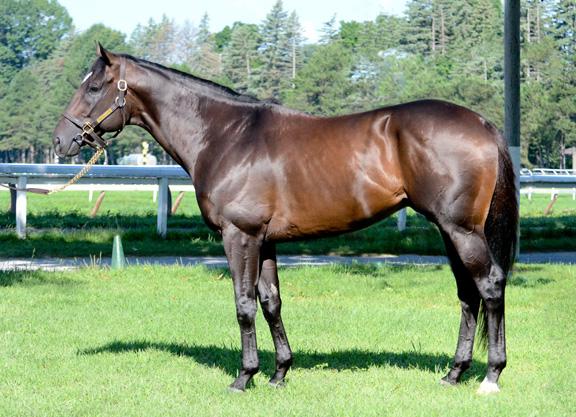
Mosler | Ellen Pons
Mosler (War Front–Gold Vault, by Arch) has built quickly on his regional freshman title with Hello Hot Rod gamely holding out to complete a hat trick in the Jimmy Winkfield S. the other day. He's the second stakes winner to emerge from Mosler's debut crop, following Miss Nondescript in the Maryland Millions Lassie S., likewise a dirt sprint. But clearly his stock can be expected to emulate his own versatility in terms of surface, once given the chance, and there's a broader sense that he is only just getting going: he's had 13 winners so far from just 28 starters among 71 named foals in his first crop.
Grade II-placed and equal to four campaigns on the track, Mosler offers a conduit to the genes and physique that qualified him as a $1.05-million yearling. He's a half-brother to dual Grade I winner Contested (Ghostzapper) out of a half-sister to Pomeroy, winner of marquee Saratoga sprints in the Forego and King's Bishop, and ultimately traces to triple Classic winner Imprudence (Fr). The big dynamo in his pedigree, however, is the replication of grandsire Danzig behind his damsire, Arch, who was out of Danzig's daughter Aurora.
Mosler, standing at $4,000, will do well to consolidate on his freshman title as impressively as Golden Lad (Medaglia d'Oro), who arguably warranted a rise from $5,000 at Northview after finishing behind only set-your-clock studmate Great Notion (Elusive Quality) in Maryland earnings last year. Out of a stakes-winning half-sister to Dialed In (Mineshaft), he has scored some big sales and is motoring along with three-figure books.
The last word here, however, is reserved for one of the most remarkable stallions in the whole country in Fiber Sonde (Unbridled's Song–Silken Cat, by Storm Cat), who continues to turn out remarkable results from Beau Ridge Farm in West Virginia at a fee of just $1,000. In 2020, this unraced half-brother to Speightstown (Gone West) had eight black-type winners among 53 overall from 96 starters; while his lifetime stakes horses represent 12.2% of named foals.
John McKee bought him for just $8,000 in 2007 and there can't be many horsemen around who have secured–or offered–more horse-per-dollar in recent times. My respect to you, sir!
CALIFORNIA
The most accomplished trainer in the land keeps producing champions out of its most beautiful track, which has itself addressed some big challenges in impressive fashion. So it would certainly be heartening to see some fresh blood invigorating the Cal-bred program. The rookie stallions launched over the past couple of years are working from a small footprint of cheaply bred horses, however, and only a handful appear to be starting up this spring.
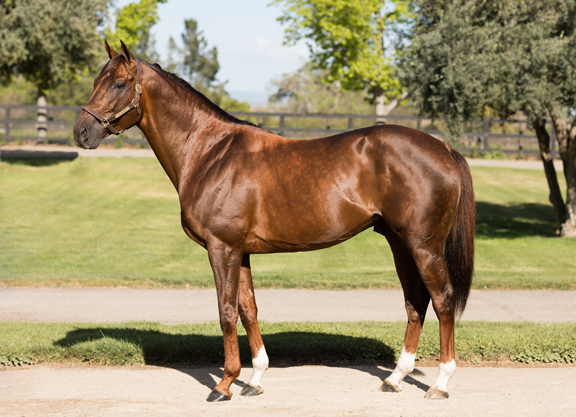
Cat Burglar | Elizabeth Hay
A couple of those about to launch their first juveniles have had plenty of support, however, including Danzing Candy (Twirling Candy) at Rancho San Miguel, who herded up 329 mares in his first three books. Hopes must also be high at Barton Thoroughbreds for Cat Burglar (Unbridled's Song–Be My Prospect, by Forest Wildcat), who launches his first juveniles this year. A hard-knocking, Grade II-placed campaigner from the family of Eight Belles (same sire) and Belong to Me (Danzig), he has been priced to have every chance at $2,500 and it's surely auspicious that he welcomed his biggest book yet in his third year.
New blood is never confined to outright rookies, however. Stay Thirsty (Bernardini) has shown the kind of demand that can be achieved by incomers, though he will only have his first state-bred runners this year; it'll be 2022 before Californian dollars start to put some perspective on the Japanese riches amassed by I'll Have Another (Flower Alley); and 2023 before another globetrotter, Sir Prancealot (Ire) (Tamayuz {GB}), can test a reputation established by migrants on local tracks. That reputation is sufficient to have secured him the premier fee in the state, and the one thing nobody should have any reservations about is his own sire. (Tamayuz belongs to the modern European breed's royal family and has himself proved an admirable achiever, given the mares operating at his level of the market.)
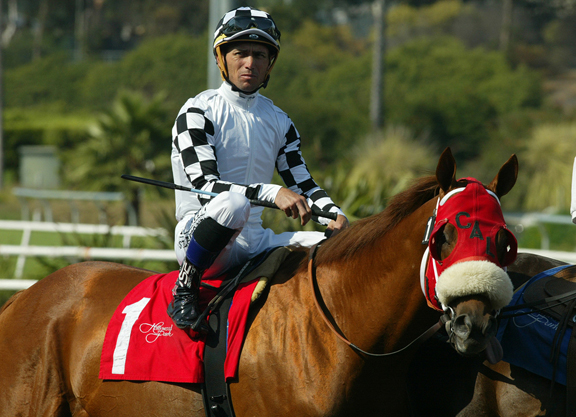
Clubhouse Ride | Horsephotos
The developing story among those who have been here from the outset remains Clubhouse Ride (Candy Ride {Arg}–Seeking Results, by Seeking the Gold), listed at $3,500 by Legacy Ranch. He continues to discover striking quality from small numbers, and has already maintained his momentum in 2021 with Brickyard Ride (now six-for-12) showing blistering pace to win his stakes debut (Beyer 99) in the California Cup Sprint. This is a barnmate of graded stakes winner Warren's Showtime, who made the podium in the GI Del Mar Oaks last summer; and also of Margot's Boy, who missed the GII Del Mar Derby only by a head. All three are in the care of Craig Lewis, who supervised their sire's millionaire career through 43 starts, including Grade I podiums at ages two and six. Clubhouse Ride is out of a half-sister to GI Jockey Club Gold Cup winner River Keen (Ire) (Keen {GB}) from an interesting family, so it's no mystery. His books are going up now and he has really earned his stripes.
Another whose stature grows by the year is Smiling Tiger (Hold That Tiger–Shandra Smiles, by Cahill Road), who produced another five stakes winners in 2020. A multiple Grade I winner himself, he has already produced one to emulate that distinction in Spiced Perfection, and at $7,500 is taking an important role in a new phase for Harris Farms following the loss of Unusual Heat and Lucky Pulpit in 2017.
But the old guard remains admirably represented there by Vronsky (Danzig–Words of War, by Lord At War {Arg}) at $3,500. This very well-bred veteran's average crop only comprises a couple of dozen foals, but he has had a Grade I winner in his time and has certainly made a very sprightly start to 2021: The Chosen Vron following through an impressive debut score by tailcoating an exciting Baffert pair in the GII San Vicente S. last weekend, while the farm's homebred Closing Remarks won the $200,000 California Cup Oaks last month. We know that some of these expensive Kentucky start-ups won't even manage his last month's work in their whole careers, but this is not supposed to be an easy business at any point of the compass.

The post Sires for 2021: The Regional Scene appeared first on TDN | Thoroughbred Daily News | Horse Racing News, Results and Video | Thoroughbred Breeding and Auctions.
Source of original post
